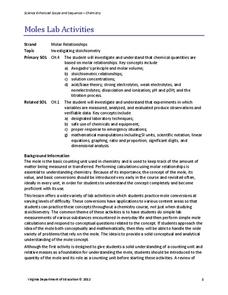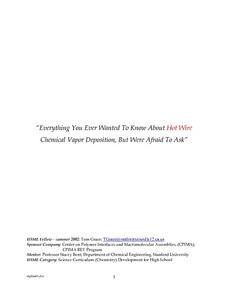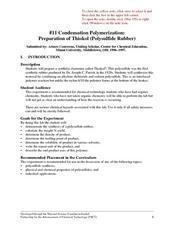Curated OER
Water Vapor Equilibrium
In this chemistry worksheet, students complete 12 short answer questions and problems on water vapor equilibrium. They calculate equilibrium concentrations of reactants and products.
Curated OER
Column Chromatography
Learners research the mechanics of liquid chromatography. For this technology lesson, students calculate the concentration of unknown samples. They write a report about their research and lab results.
Curated OER
Omega and Eigenfunction
In this chemistry instructional activity, students calculate the eigenfunction of the operator. They use the operator matrices. There are 4 questions.
Curated OER
Student - Designed Density Experiment and Poster
In this student-designed experiment worksheet, learners decide on an experimental problem to solve. Students use the scientific method to perform an experiment and record the data. Learners calculate the density of liquid used in the...
Curated OER
Minerals and Rock Cycle Review
In this minerals and rocks worksheet, students answer questions about the chemistry of minerals, scratch tests, rocks and the rock cycle, and erosion and deposition.
Curated OER
Chemistry Activity 29
In this chemistry worksheet, students write the balanced chemical equation for each. Then they calculate the mass of nitrogen dioxide created with specific amounts of nitrogen and oxygen. Students also identify how many grams of the...
Curated OER
Chemistry: Significant Digits
In this significant digits learning exercise, learners review the rules of working with significant digits and then give the number of significant digits in the given measurements. This learning exercise has 30 problems to solve.
Curated OER
Moles Lab Activities
General chemistry class members engage in a mini-unit on mole conversions. Through nine lab activites with varying degrees of difficulty, they practice measuring mass and volume, molar calculations, and stoichiometry. Terrific...
Curated OER
Bubble and Boyle
Even middle schoolers still enjoy experimenting with bubbles! They execute a series of experiments enabling them to distinguish between convex and concave surfaces, explore the properties of buoyancy, surface tension, and density,...
Curated OER
Everything You Ever Wanted To Know About Hot Wire Chemical Vapor Deposition, But Were Afraid To Ask
To wrap up your year of general chemistry, have lab groups compete in a tot wire chemical vapor deposition (HWCVD) competition. With their foundation in chemical nomenclature, stoichiometry, and gas laws, each group completes several...
Curated OER
Chapter 15 Review, Section 2: Acid-Base Titration and pH
Keep it simple with this chemistry assignment. Learners examine an acid-base titration graph and answer four questions about the data. Then they will balance neutralization equations and calculate molarity for several specific solutions....
Curated OER
History of the Atom
This is a tremendous overview of the tiny atom. Journey through the history of human understanding of this basic building block of matter. Examine each of the sub-atomic particles in detail: neutrons, protons, electrons, quarks. Peruse...
Curated OER
Condensation Polymerization: Preparation of Thiokoll® (Polysulfide Rubber)
This lab activity is geared toward experienced chemistry learners, in particular, those who are familiar with organic chemistry. They will create a synthetic elastomer and then make observations and measurements of its different...
Curated OER
Catalytic Converter
Two animated slides explain the decomposition reactions that occurs within a catalytic converter. An enthalpy diagram is displayed. Hess's Law is demonstrated. Finally, the analogy of football is used to explain Hess's Law. This...
American Chemical Society
Density: Sink and Float for Liquids
We don't think of liquids as floating typically, but a quick look at any oil spill tells a different story. Lesson explores various densities of liquids and why this fact is important. After observing the density variation, scholars...
Curated OER
The Visible Spectroscopy Expert Witness Problem
In a simulated crime science investigation, chemistry or physics sleuths use spectroscopy to analyze solutions. The lesson gives learners practice making salicylate solutions, using spectrophotometers, calculating dilution amounts,...
University of Georgia
Endothermic and Exothermic Reactions
Equip your chemistry class with the tools to properly understand endothermic and exothermic reactions. Young chemists collect, analyze, and graph data to determine how the Law of Conservation of Matter is applied to chemical...
Curated OER
More Moles Calculations
In this moles worksheet, students determine the number of grams or moles in the given amount of chemical compound. This worksheet has 5 problems to solve.
Curated OER
Lab: Percent of Composition of KClO3
Students find the percent of oxygen in potassium chlorate. In this percent composition lesson plan, students heat a solution of potassium chlorate using a catalyst, manganese dioxide, to decompose the potassium chlorate and release...
Curated OER
Living Environment 2006
In this chemistry worksheet, students answer 41 multiple choice question and 28 short answer questions to prepare for Living Environment Regents Exam.
Curated OER
Energy and States of Matter
Characteristics of each state of matter are listed, the formulas for heating water are detailed, and values for boiling and heat of vaporization are presented. This simple slide show provides direct instruction as well as practice...
Curated OER
Quality Control at Kality Krunchers Dill Pickle Factory
In a hypothetical scenario, food chemists use titration to concoct a brine solution for producing the crunchiest pickles. They also analyze store-bought pickle juices. In addition to reinforcing titration techniques, the lesson requires...
Curated OER
How can we calculate the molecular weight of butane?
Students colloborate in a lab experiment. No OBJECTIVES.
Curated OER
Quiz 2-Chemistry Reaction Rates
For this rate of reactions quiz, students solve three problems related to chemical reactions and their rates including rates of decay and rate constants.























